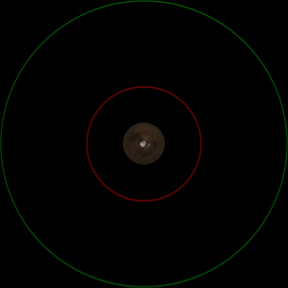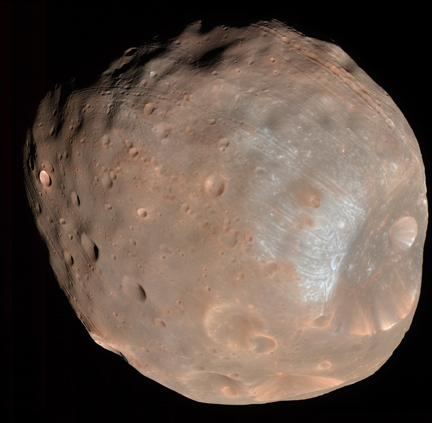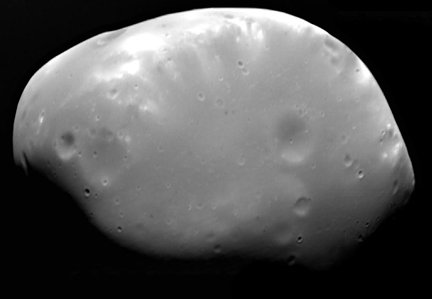Mars' Moons
Overview
 |
| This shows the planet Mars as seen looking down on the North Pole. It also shows the orbital path of Phobos (red) and Deimos (green) to-scale relative to the planet's size. Digital Projection Created by Stuart Robbins. |
When most people think of a moon, they think of the relatively large whitish globe that they see at night (and sometimes during the day) above our own planet. While this is a moon, it is not typical of moons in the solar system. Most moons are rather small, especially relative to their parent body's size.
Mars' two moons are more typical of the moons in the solar system. They are fairly small, smaller than a city on Earth, with Phobos measuring 13.4 by 9.2 km and Deimos 7.5 by 5.2 km. Both moons are heavily cratered, and both moons are covered with a fine dust as well as boulders.
Mars' moons also orbit very close to Mars. The illustration on the right shows the relative sizes of the orbits. This image is to-scale, meaning that the planet's actual size is to-scale with respect to the sizes of the moons' orbits.
It is not known what the origin of Mars' moons is. Due to their tiny size and composition, it is believed that they were captured asteroids. However, they are both in highly circular orbits that are almost exactly in the same plane as Mars' equator. It is difficult for this to happen without highly unlikely events, and so the origin of the moons remains an active area of current debate.
History
Unlike the planet itself, Mars' moons have not been known since antiquity. Rather, they were discovered in 1877 by a keen-eyed U.S. astronomer in Washington, D.C. In a hazy August evening, Professor of Mathematics in the U.S. Navy Corps of Mathematics, Asaph Hall, was studying Mars with the 26" "Great Equatorial" telescope at the U.S. Naval Observatory with his assistant, George Anderson.
Prof. Hall was sweeping the telescope around the edge of Mars when he saw what looked like a star - except that he had seen it five nights earlier along with the planet. He noted that it appeared to be moving with Mars as opposed to staying fixed relative to the other stars around it. Later that night, he saw a brighter "star" that was even closer to the planet's disk.
On August 18 of that year, several astronomers came to the telescope with Hall and observed the "stars," recording their positions in the telescope's log book. Mars' to moons, Phobos and Deimos, had been discovered.
The two satellites were originally spelled as "Phobus" and "Deimus," though the current spelling was later adopted. The names were suggested by the Science Master of Eton, Henry Madan (Madan, 1877; Hall, 1878), based upon the Greek poet Homer's fifteenth book of the Iliad.
Not too much could be discerned about the moons until spacecraft were actually sent to Mars other than their orbital characteristics (the length of their day, their distance from Mars, etc.). Once probes reached Mars, the moons could be photographed and their sizes, mass (and hence densities), and geology could be discerned.
In addition, NASA's Mars Exploration Rovers photographed the two moons several times during their operation life on Mars, and those photographs of the precise locations of the moons have helped to refine our understanding of their orbits.
 |
| This shows the planet Mars as seen looking down on the North Pole. It also shows the orbital path of Phobos (red) and Deimos (green) to-scale relative to the planet's size along with the moons, with the moons' sizes increased by a factor of 50. Digital Projection Created by Stuart Robbins. |
Origin of the Moons
As mentioned in the Overview, the origin of Mars' moons is not entirely clear. The spectral composition of the moons (discussed below) indicates that they are very similar to known asteroids. In addition, they are very small objects, and it is generally assumed that tiny moons such as Phobos and Deimos were captured. In this sense, their physical characteristics strongly indicate a captured asteroid origin.
However, their orbital characteristics are strong indicators that the moons formed in orbit of Mars. This is because their orbits are very circular and their orbital inclination - the angle their orbit makes relative to Mars' equator - is almost 0°. This generally indicates the object formed with the planet because it requires some other mechanism to circularize the orbit of a captured object. (A captured object should have a large eccentricity (between 0 and 1) and a random inclination (between 0 and 90°).)
Possible mechanisms have been proposed to circularize the orbits. These mainly focus on tides and/or atmospheric drag (e.g., Hunten, 1978), but these are not strong enough at the location of Deimos to circularize its orbit within the lifetime of the solar system. In addition, Mars' present-day atmosphere is not voluminous enough to significantly affect Phobos' orbit, which would thus require a much more massive atmosphere in Mars' past.
Another proposal is that Mars' moons formed in a similar manner as our moon: A giant impact event launched material into Mars orbit that coalesced to form Deimos and Phobos. It could also have formed other moons that have already crashed into Mars, forming the few large and highly elliptical craters that are seen today. This could also explain the moons' low densities in that the moons never accreted enough mass to form a completely solid body like our own moon, but rather they are "rubble piles." (See, e.g., Craddock, 1994.)
Phobos (MI, S/1877 M1)
 |
| Phobos showing Stickney crater on the right, as imaged by the Mars Reconnaissance Orbiter's HiRISE camera. This is a composite image from Infrared, Red, and Blue filters. Original image from the HiRISE website. |
Overview: Phobos is the larger of the two moons of Mars, and it also orbits closer to the planet than Deimos. For both of these reasons, it has been better-imaged than its counterpart, including the highly detailed HiRISE image shown on the right.
Major Characteristics: The landscape of Phobos is dominated by the large crater Stickney, shown on the right of the moon in the HiRISE image. The crater was named after the wife of Asaph Hall, Chloe Angeline Stickney Hall.
This crater is about 9 km in diameter. Grooves and chains of craters appear to radiate from Stickney. It is generally thought that the grooves and chains were formed by Stickney's formation (e.g., Wilson & Head, 2005). They would have formed from material that was both ejected from the impact event as normal secondary craters, but also from ejected material rolling across the surface of the small moon.
However, recent mapping from the Mars Express orbiter has suggested that many of the grooves and crater chains may be unrelated to Stickney (e.g., Murray et al., 2006). Their observations show that while most of the grooves appear to radiate from Stickney, that is mainly due to Stickney being near the leading edge of the moon's orbit. Their photographs show that many of the groove do not radiate from the crater, but that nearly all of them radiate from the leading point of the moon. They suggest that each "family" of grooves and chains is a result of impact ejecta, launched into orbit, from events on the planet below.
Besides the large grooves and chains, Stickney and other craters on Phobos appear to have lines radiating outward from the center, and these were caused by landslides from materials falling into it. In addition, there are other regions of the moon that show evidence of general "mass-wasting" events - erosion due to gravity pulling material closer towards its center (Shingareva & Kuzmin, 2001).
Composition: The composition of Phobos and Deimos is determined through their spectra, which show now much light an object reflects (and/or emits) at individual wavelengths. In general, researchers try to match spectra to objects of known composition, or at least a specific, distinct compositional class. In Mars' moons' case, they are matched to classes of asteroids or meteorites.
The spectra of Phobos, which over the years has been measured from the ground, from space telescopes like the Hubble Space Telescope, and spacecraft like Mariner 9, Viking, and Phobos 2. These have shown that Phobos most closely resembles type CI and CM carbonaceous chondrites (see, e.g., Muchie & Zellner, 1994).
Tidal Evolution of Phobos' Orbit and Eventual Destruction: Since both of the moons lie closer to Mars than a synchronous orbit, they orbit faster than Mars spins. Thus, the very small tidal bulge that they cause on Mars lags slightly behind the moons, especially Phobos. This creates an effective drag force on the moons, and as a result, Phobos is slowly spiraling towards Mars at a current rate of 18.3 cm (7.20 inches) per year; at this rate, it will hit Mars in about 50 million years.
However, the tidal forces upon Phobos due to Mars are much larger. An astronomer named Edouard Roche (1820-1883) developed the concept of the "Roche Limit," which is how close an object can come to another before it will be destroyed due to the tidal forces across it. The Roche Limit is expressed as:

For the Mars-Phobos system, the Roche Limit is estimated at 10,800 km. However, Phobos is inside of this limit. The reason that it can survive inside the Roche Limit is that the equation does not take into account the actual strength of the material that the object is made of. If Phobos were nothing but a pile of rubble, then it would likely have disintegrated by now, but because it is at least partly made of much larger chunks of rock, it hasn't.
With this in mind, the best estimate is that the Roche Limit is about 5000 km for Phobos (Venable, 2001). Once Phobos comes within this, the moon should be destroyed by tidal forces, and Mars will develop a small ring system.
Deimos (MII, S/1877 M2)
 |
| Black-and-White mosaic of Deimos, taking by the Viking Orbiter 2 spacecraft. |
Overview: Despite Deimos being generally similar to Phobos and so seemingly of similar interest, Deimos is much less-studied than its partner. Reasons for this include Deimos being smaller and so harder to observe (and assumed to be less geologically interesting). In addition, its orbit is farther from Mars, and the majority of high-quality observations of Phobos have come from spacecraft that were sent to study Mars and happen to be close enough to Phobos to return good data, but too far from Deimos.
Composition: Deimos' spectra is markedly different from Mars, which shows several absorption features that tell us about its surface composition. The visible-light and near-IR spectra of Deimos is fairly flat, showing no significant absorption lines, though it rises steadily towards the red end. This is consistent with fine-grained carbonaceous chondrite material, or C-Type asteroids (Grundy & Fink, 1991).
However, it has also been proposed that Deimos has a similar composition to a D- or P-Type asteroid. These types are believed to be covered in dark organic materials and material that may be partially composed of clays that have been enriched with water (Grundy & Fink, 1992).
Data for the Moons
The following table presents selected information from NASA's planetary factsheet.
| Phobos | Deimos | |
|---|---|---|
| Semi-Major Axis* (103 km) | 9.378 | 23.495 |
| Orbital Inclination (from Mars' Equator) | 1.08° | 1.79° |
| Orbital Eccentricity | 0.0151 | 0.0005 |
| Major Axis Radius (km) | 13.4 | 7.5 |
| Average Axis Radius (km) | 11.2 | 6.1 |
| Minor Axis Radius (km) | 9.2 | 5.2 |
| Mass (1015 kg) | 10.6 | 2.4 |
| Density (water=1 g/cm3) | 1.90 | 1.75 |
| Sidereal Rotation Period (hours) | 7.6533 | 30.2983 |
| Sidereal Orbital Period (hours) | 7.65 | 30.29 |
| Geometric Albedo | 0.07 | 0.08 |
| Visual Magnitude | +11.8 | +12.89 |
| Discoverer | A. Hall | A. Hall |
| Discovery Date | 1877 | 1877 |
*Distance is from the center of the planet, not its surface.